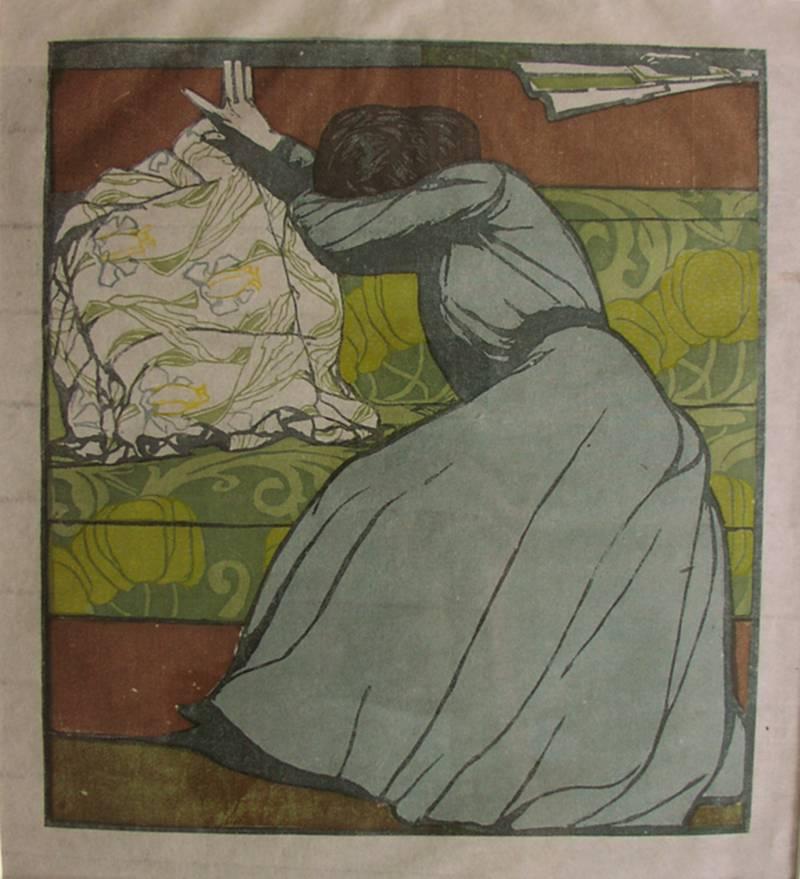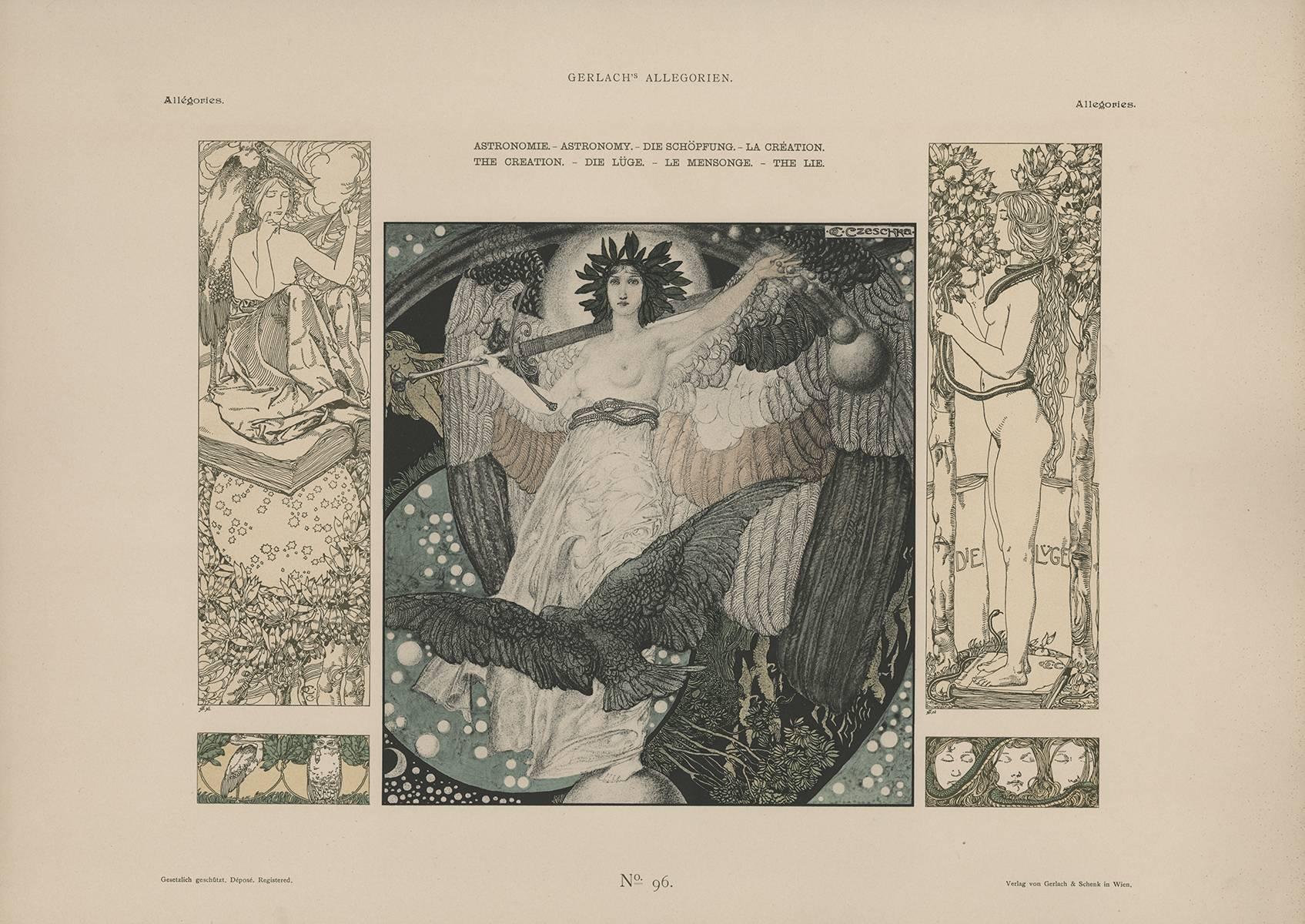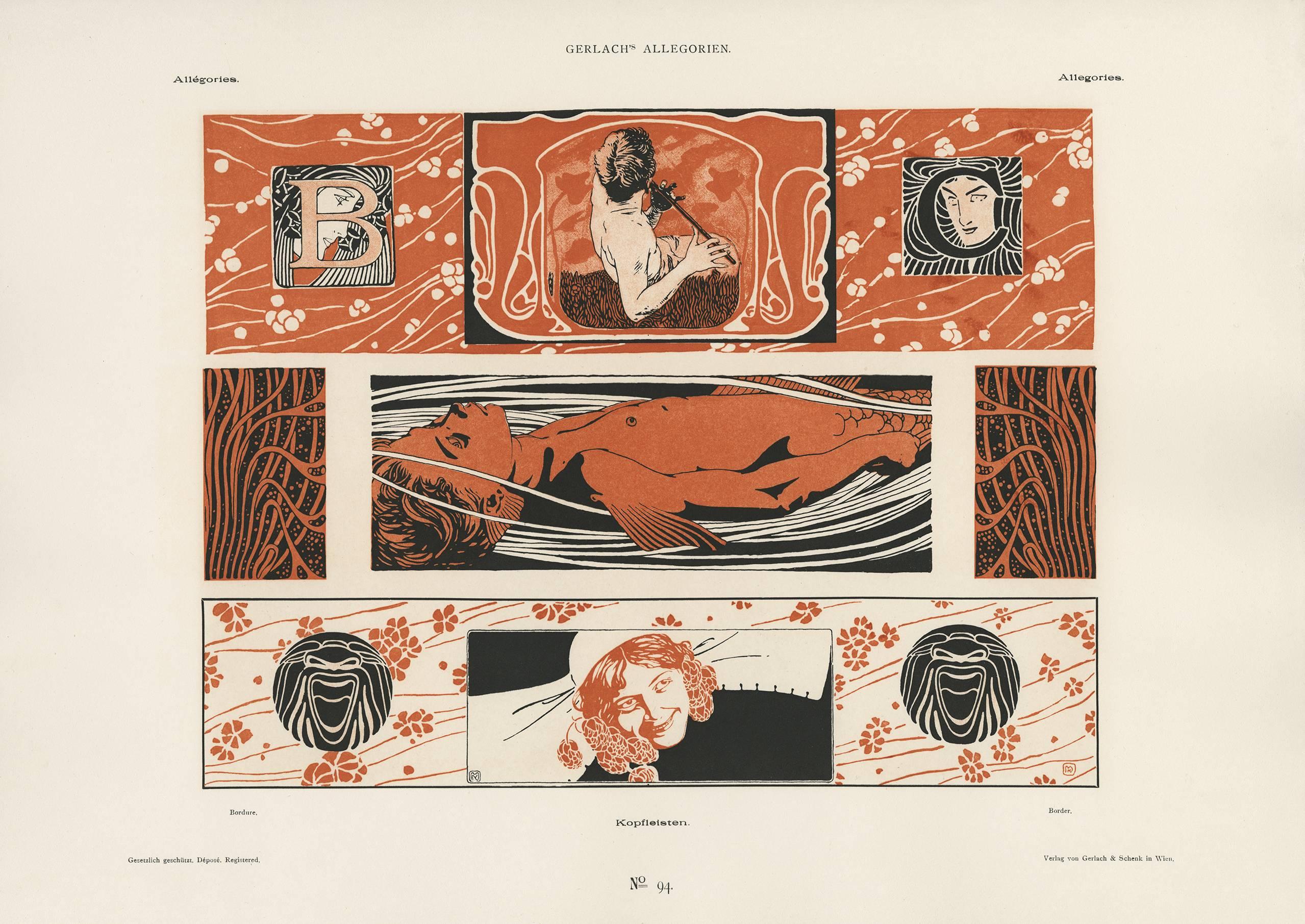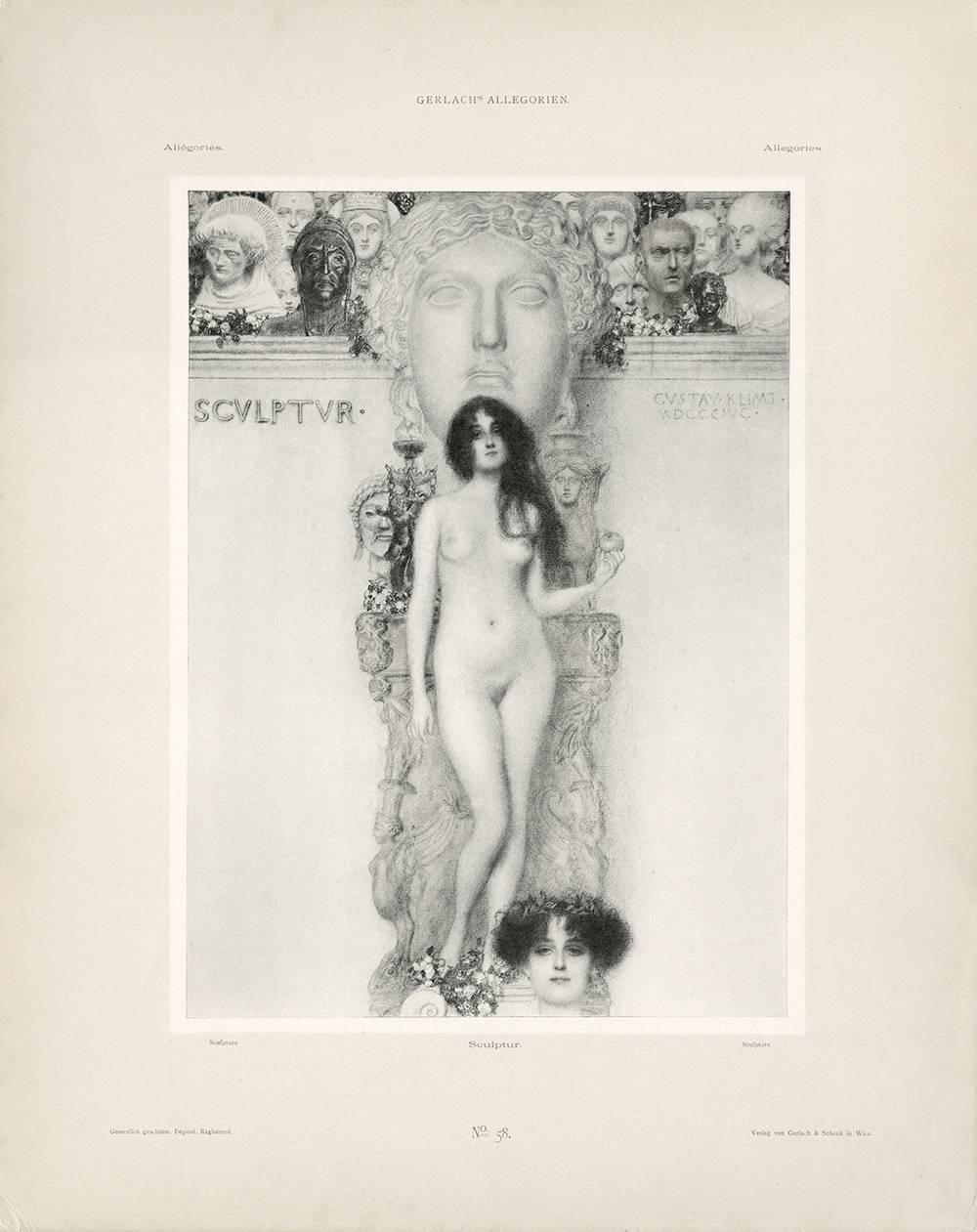Items Similar to Ottokar Mascha Folio, plate 8: "Poster for the 1st Vienna Secession Exhibition"
Want more images or videos?
Request additional images or videos from the seller
1 of 6
Gustav KlimtOttokar Mascha Folio, plate 8: "Poster for the 1st Vienna Secession Exhibition"1915
1915
About the Item
After GUSTAV KLIMT (1862-1918) THESEUS UND MINOTAURUS, 1898, final design submission for poster advertising the first exhibition of the Vienna Secession, (In Mascha, no. 8) As a celebrated Austrian artist and President of the newly formed Vienna Secession, it was especially fitting that Klimt designed the poster advertising the group’s first exhibition. Klimt takes an iconoclastic approach to allegory: “Theseus killing the Minotaur”, taken from Ancient Greek mythology, personifies the fight of Modern Free Art against Academic Art. Ironically, the Austrian government censored this version for what they deemed to be too overtly rendered male genitalia; a subsequent and final version of this poster’s image shows the addition of tree branches. Perhaps Klimt’s free speech is better voiced in the poster’s modern design vocabulary which features a central monochromatic panel balanced by geometric sections of vertical and horizontal rectangles and a circular shield. These same elemental shapes dominate the block lettering and stylized pattern found on Athena’s helmut and shield.
OTTOKAR MASCHA (1852-1929), OSTERREICHISCHE PLAKATKUNST, 1915, J. Lowy Printer, in an edition of 230. Framed (see images).
Austria’s foremost collector of poster prints, Ottokar Mascha amassed one of the largest international graphic art collections of the time. He was an active member in poster-collecting societies, and he gave generously to educational and other public institutions. In many cases, examples found in his collections were the sole survivors of an ephemeral medium whose delicate papers could not hold up over time to the damaging effects of animal glue, weathering, and other wear and tear from excessive handling. Mascha recognized that posters were not only cultural documents, but works of art. He devised ways to obtain pristine examples for his collection often through the police with whom posters needed to be submitted for approval prior to being hung in public. As Mascha explains in the forward and introduction of Plakatkunst, he saw a need in Austria for developing and promoting the poster as an artistic medium. His aims in publishing Plakatkunst were lofty; Mascha hoped to educate new and aspiring Austrian artists by exposing them to the possibilities the poster medium offered, and he hoped to develop a broader collector base through connoisseurship. His carefully selected examples of posters from his collection are archives of a nearly lost time. Preserved within this rare printed work are contextual links to Austria’s interconnected modern arts culture of which the Vienna Secession played a central role. Like the members of Vienna’s Secession, Mascha believed that modernity required a new definition of Art and that old hierarchical notions were out of touch. Creating a leveling force in the arts, where graphic and applied arts are valued equally as painting, sculpture and architecture, was an over-arching goal many were grappling to achieve at this time. He also shared the belief that, whether native or adoptive, there was, indeed, an Austrian sensibility whose zeitgeist he wanted to capture and preserve. For him, it was a question of accessibility. Today, bombarded as we are with digital and graphic images and their instant access we have literally at our fingertips, it is easy to forget that 100 years ago this was simply not the case. Plakatkunst, was, and is, an invaluable resource; it is a bold statement which continues to resound that the artistic merit of successful posters will stand the test of time.
- Creator:Gustav Klimt (1862 - 1918, Austrian)
- Creation Year:1915
- Dimensions:Height: 22 in (55.88 cm)Width: 18.5 in (46.99 cm)Depth: 3 in (7.62 cm)
- Medium:
- Movement & Style:
- Period:
- Condition:
- Gallery Location:Chicago, IL
- Reference Number:1stDibs: LU467314042672

About the Seller
5.0
Gold Seller
These expertly vetted sellers are highly rated and consistently exceed customer expectations.
Established in 2013
1stDibs seller since 2016
82 sales on 1stDibs
Typical response time: 1 hour
- ShippingRetrieving quote...Ships From: Chicago, IL
- Return PolicyA return for this item may be initiated within 3 days of delivery.
More From This SellerView All
- Gerlach's Allegorien Plate #116: "Force, Thirst, Love" LithographBy Carl Otto CzeschkaLocated in Chicago, ILafter Carl Otto Czeschka, (1878-1960), Austrian A leading member of the Vienna Secession and later the Wiener Werkstätte (Viennese Workshop), Carl Otto Czeschka was a vital figu...Category
1890s Vienna Secession Figurative Prints
MaterialsLithograph
- Gerlach's Allegorien Plate #94: "Heads" LithographBy Koloman MoserLocated in Chicago, ILKoloman Moser (1868 –1918), AUSTRIAN Instead of applying his flair and art education solely to painting, Koloman Moser embodied the idea of Gesamt Kunstwerk (all-embracing art work) by designing architecture, furniture, jewelry, graphics, and tapestries meant to coordinate every detail of an environment. His work transcended the imitative decorative arts of earlier eras and helped to define Modernism for generations to come. Moser achieved a remarkable balance between intellectual structure (often geometric) and hedonistic luxury. Collaborating with Gustav Klimt and Josef Hoffmann, the artist was an editor and active contributor to Ver Sacrum, (Sacred Spring), the journal of the Viennese Secession that was so prized for its aesthetics and high quality production that it was considered a work of art. The magazine featured drawings and designs in the Jugendstil style (Youth) along with literary contributions from distinguished writers from across Europe. It quickly disseminated both the spirit and the style of the Secession. In 1903 Moser and Hoffmann founded and led the Wiener Werkstatte (Viennese Workshop) a collective of artisans that produced elegant decorative arts items, not as industrial prototypes but for the purpose of sale to the public. The plan, as idealistic then as now, was to elevate the lives of consumers by means of beautiful and useful interior surroundings. Moser’s influence has endured throughout the century. His design sensibility is evident from the mid-century modern furniture of the 1950s and ‘60s to the psychedelic rock posters...Category
1890s Vienna Secession Figurative Prints
MaterialsLithograph
- Gerlach's Allegorien Plate #98: "Poetry" Lithograph by Carl Otto CzeschkaBy Carl Otto CzeschkaLocated in Chicago, ILafter Carl Otto Czeschka, (1878-1960), Austrian A leading member of the Vienna Secession and later the Wiener Werkstätte (Viennese Workshop), Carl Otto Czeschka was a vital figu...Category
1890s Vienna Secession Figurative Prints
MaterialsLithograph
- Gerlach's Allegorien Plate #85: "Hunting" Lithograph by Carl Otto CzeschkaBy Carl Otto CzeschkaLocated in Chicago, ILafter Carl Otto Czeschka, (1878-1960), Austrian A leading member of the Vienna Secession and later the Wiener Werkstätte (Viennese Workshop), Carl Otto Czeschka was a vital figu...Category
1890s Vienna Secession Figurative Prints
MaterialsLithograph
- Gerlach's Allegorien Plate #30: "Love" LithographBy Koloman MoserLocated in Chicago, ILKoloman Moser (1868 –1918), AUSTRIAN Instead of applying his flair and art education solely to painting, Koloman Moser embodied the idea of Gesamt Kunstwerk (all-embracing art w...Category
1890s Vienna Secession Figurative Prints
MaterialsLithograph
- Gerlach's Allegorien Folio, plate #53: "Junius" Lithograph, Gustav Klimt.By Gustav KlimtLocated in Chicago, ILContributors to Gerlach & Schenk’s publications valued design and innovation in the graphic arts just as much as they examined allegories as subject matter for exploration. Here, Gus...Category
1890s Vienna Secession Figurative Prints
MaterialsLithograph
You May Also Like
- Der PolsterBy Max KurzweilLocated in New York, NYKurzweil, Maximilian. Der Polster, 1903. Color woodcut on japon. Included as an insert in Pan. Unsigned. Framed.11 1/4 x 10 1/4. 1 Ref: Hofstatter, p. 241; Pabst, p. 154. Maximillian Kurzweil was the co-founder of the Vienna Secession in 1897 and editor and illustrator of the influential Secessionist magazine Ver Sacrum...Category
Early 1900s Vienna Secession Figurative Prints
MaterialsLithograph
- Mädchen am Fenster. 1906-08.By Oskar KokoschkaLocated in New York, NYMädchen am Fenster. 1906-08. Color lithograph printed on smooth card stock. Full margins. Tipped into a later presentaion folder, signed by the artist in pencil, on the recto. Published by the Wiener Werkstätte, Vienna, with the printed postcard text on verso. Among Kokoschka's earliest prints were a series of 14 postcards, the current work and the following lot that he produced for the Wiener Werkstätte. Wingler/Welz 4. Oskar Kokoschka was an Austrian artist, poet and playwright best known for his intense expressionistic portraits...Category
Early 1900s Vienna Secession Figurative Prints
MaterialsLithograph
- Original Vintage Secession Poster celebrating the emperor's jubileeLocated in Zurich, CHOriginal Vintage Poster by the Austrian artist Ferdinand Ludwig Graf, a member of the Hagenbund. This Viennese artist association moved as soon a...Category
Early 1900s Vienna Secession Figurative Prints
MaterialsPaper
- Untitled WoodcutLocated in Wilton, CTOriginal hand-colored woodcut from a portfolio of Secessionist fashion illustrations. Signed in the lower right margin by the artist, Reni Schaschl (1895-1979), a talented member of...Category
1910s Vienna Secession Figurative Prints
MaterialsWoodcut
- FruhlingBy Josef Siccard-RedlLocated in New York, NYSiccard-Redl, Josef. Fruhling, Ca 1910. Color wood engraving, Signed and titled in pencil by the artist. Little is known of this artist other than he worked in Vienna during the ...Category
1910s Vienna Secession Figurative Prints
MaterialsEngraving
- Of Youth —after Gustav Mahler's 'The Song of the Earth'Located in Myrtle Beach, SCArthur Paunzen, 'Von der Jugend' (Of Youth) from the suite 'Song of the Earth', etching, aquatint, and drypoint, 1920. Signed and titled in pencil. Signed in the plate, lower left. A fine, richly-inked impression, on cream, wove Japan paper; the full sheet with margins (2 1/4 to 4 1/4 inches), in good condition. Image size 12 1/4 x 9 1/16 inches; sheet size 19 3/4 x 13 5/8 inches. Matted to museum standards, unframed. ABOUT THIS WORK Pauzen’s suite of six etchings 'Das Lied von der Erde' (The Song of the Earth), published in 1920, was inspired by Gustav Mahler...Category
1920s Vienna Secession Figurative Prints
MaterialsEtching, Drypoint, Aquatint




